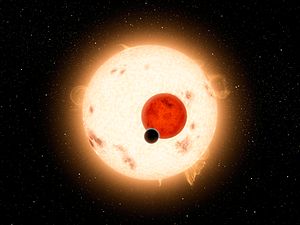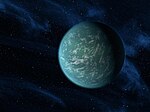开普勒16b
| 太阳系外行星 | 太阳系外行星列表 | |
|---|---|---|
 | ||
| 母恒星 | ||
| 母恒星 | 开普勒16 | |
| 星座 | 天鹅座 | |
| 距离 | 200[1] ly (61 pc) | |
| 轨道参数 | ||
| 半长轴 | (a) | 0.7048 ± 0.0011 AU |
| 轨道离心率 | (e) | 0.0069 ± 0.0015 |
| 公转周期 | (P) | 228.776 ± 0.037 d |
| 轨道倾角 | (i) | 90.0322 ± 0.0023° |
| 物理性质 | ||
| 质量 | (m) | 0.333 ± 0.015 MJ |
| 半径 | (r) | 0.22623 ± 0.00059 RJ |
| 密度 | (ρ) | 0.964 ± 0.047 g cm-3 |
| 表面重力 | (g) | 14.52 ± 0.7 m/s² |
| 温度 | (T) | 170 - 200 K |
| 发现 | ||
| 发现时间 | 2011年7月7日 | |
| 发现者 | 劳伦斯·多伊[2] | |
| 发现方法 | 凌日法 (开普勒空间望远镜) | |
| 发表论文 | Published | |
| 数据库参考 | ||
| 太阳系外行星 百科全书 | data | |
| SIMBAD | data | |
开普勒16b(Kepler-16b)是一个环绕食双星的太阳系外行星,体积相当于土星。其组成成分可能是岩石和气体各半[3]。这是首个确认的环联星运转行星[4][5],公转周期229日[6]。
简介
[编辑]
该行星是由NASA的开普勒空间望远镜发现[7]。科学家发现到该行星通过联星系统的其中一颗恒星前方,使其光度降低,但另一颗恒星光度却未降低的情况,因而发现了它[7]。更进一步来说,该行星的凌日状况允许科学家以极高精确度计算开普勒16系统中天体质量[8]。发现该行星团队的主持人,任职于加州山景城SETI中心的劳伦斯·多伊,形容其精确度是“我相信这是太阳系外测量精度最高的”(I believe this is the best-measured planet outside the solar system.)[8]。例如该恒星半径的误差值只有0.3%,直到2011年9月都是比其他系外行星误差少[9]。
开普勒16b是相当特殊的系统,因为该行星的轨道位于联星系形成行星的轨道下限之内[8]。麻省理工学院的行星科学家萨拉·西格(Sara Seager)表示,在联星系统中要有行星存在,行星轨道半径必须是两颗星距离的七倍以上才能形成稳定系统[8];但开普勒16b的轨道半径只有该推测距离的一半[8]。
该行星因为其表面温度大约在-100到-70 °C之间,可能不适合生命生存。
从地球上观察,开普勒16b最快将在2014年对其中一颗恒星产生凌日现象,而在2018年对另一颗较亮恒星也发生凌日;之后直到2042年都无法以凌日法观察它[8]。
名称
[编辑]在公布这项发现的论文中,发现它的团队表示,根据惯例[10],应该称呼它 Kepler-16 (AB)-b,或者是在没有歧义时只加上 “b”[1]。太阳系外行星百科将它称为 Kepler-16 (AB) b[11]。SIMBAD数据库称呼它为 Kepler-16 (AB)-b[12]。
发现它的科学家非正式地以电影《星际大战》中的虚拟行星塔图因称呼开普勒16b[5] 。《星际大战四部曲:曙光乍现》中,塔图因上两个太阳同时落下的场景相当有名[8]。而工业光魔的视觉特效总监,曾为多部电影制作特效的约翰·诺尔则说“再一次地,我们看到科学事实比小说更怪异”[8]。
参考资料
[编辑]
- ^ 1.0 1.1 Laurance R. Doyle, Joshua A. Carter, Daniel C. Fabrycky; et al. Kepler-16: A Transiting Circumbinary Planet. 2011. arXiv:1109.3432v1
 [astro-ph.EP].
[astro-ph.EP].
- ^ NASA - NASA's Kepler Discovery Confirms First Planet Orbiting Two Stars. [2011-09-15]. (原始内容存档于2011-11-11).
- ^ Drake, Nadia. On Kepler-16b, shadows come in pairs. Science News. Society for Science & the Public. [16 September 2011]. (原始内容存档于2012-08-28).
- ^ From Star Wars to science fact: Tatooine-like planet discovered. Smithsonian Science. The Smithsonian Institution. [24 September 2011]. (原始内容存档于2011-09-24).
- ^ 5.0 5.1 Baldwin, Emily. Kepler planet circles two suns. Astronomy Now Online. Pole Star Publications Ltd. [16 September 2011]. (原始内容存档于2012年8月28日).
- ^ Doyle, Laurance. First Planet Orbiting Two Stars Discovered by the NASA Kepler Spacecraft. The Huffington Post. 2011-09-15 [16 September 2011]. (原始内容存档于2015-11-10).
- ^ 7.0 7.1 Gold, Scott. Scientists find planet orbiting two suns like in 'Star Wars'. Los Angeles Times. 2011-09-15 [16 September 2011]. (原始内容存档于2011-09-18).
- ^ 8.0 8.1 8.2 8.3 8.4 8.5 8.6 8.7 Overbye, Dennis. NASA Detects Planet Dancing With a Pair of Stars. The New York Times. 2011-09-15 [16 September 2011]. (原始内容存档于2011-09-16).
- ^ Winn, Joshua N.; Albrecht, Simon; Johnson, John Asher; Torres, Guillermo; Cochran, William D.; Marcy, Geoffrey W.; Howard, Adnrew W.; Isaacson, Howard; Fischer, Debra. Spin-orbit alignment for the circumbinary planet host Kepler-16 A. 2011. arXiv:1109.3198v2
 .
.
- ^ Hessman, F. V.; Dhillon, V. S.; Winget, D. E.; Schreiber, M. R.; Horne, K.; Marsh, T. R.; Guenther, E.; Schwope, A.; Heber, U. On the naming convention used for multiple star systems and extrasolar planets. 2010. arXiv:1012.0707
 .
.
- ^ Jean Schneider. Notes for Planet Kepler-16 (AB) b. Extrasolar Planets Encyclopaedia. 2011 [23 September 2011]. (原始内容存档于2011年10月11日).
- ^ Object query: Kepler-16b on the online SIMBAD Astronomical database [1] (页面存档备份,存于互联网档案馆)
外部链接
[编辑]- Kepler-16 (AB) at The Extrasolar Planets Encyclopaedia(页面存档备份,存于互联网档案馆)
- Kepler-16: A Transiting Circumbinary Planet[永久失效链接], Laurance R. Doyle et al. 2011
- Spin-Orbit Alignment for the Circumbinary Planet Host Kepler-16A (页面存档备份,存于互联网档案馆), Joshua N. Winn et al. 2011



